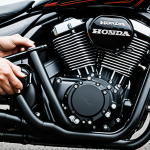Essential Tools and Preparation Checklist
Preparing to install Kawasaki Versys 300 crash bars requires gathering the right tools and setting up a safe workspace for a successful DIY project. Key tools typically include a set of socket wrenches, Allen keys, torque wrench, screwdrivers, and possibly a mallet. Having these ready ensures you can handle all bolt sizes and torque requirements during installation.
Safety gear is equally crucial. Sturdy gloves protect your hands from sharp edges, while safety glasses shield your eyes from debris. Wearing a mechanics apron or old clothing can prevent damage from grease or scratches. This gear supports a smooth, injury-free installation process.
In the same genre : Revamp Your Ride: A Complete DIY Guide to Upgrading Kawasaki ZZR1400 Foot Pegs
Immediately before beginning, clear a spacious, well-lit workspace with a flat surface to keep the motorcycle stable, tools organized, and parts within easy reach. Lifting the bike with a paddock stand or center stand can enhance maneuverability.
Proper preparation reduces common errors and streamlines the fitting of your Versys 300 crash bars. By assembling the right tools and prioritizing safety, you set the foundation for a secure, effective installation that maximizes the protection your motorcycle safety gear offers.
In parallel : Essential Guide: Perfecting Suspension Calibration for Your Ducati Hypermotard 939
Essential Tools and Preparation Checklist
Preparing correctly is crucial for a smooth Kawasaki Versys 300 crash bar installation. Begin by gathering the essential tools to avoid interruptions. You will need:
- Socket set (metric sizes, typically 8mm-14mm)
- Torque wrench for accurate bolt tightening
- Allen keys or hex wrenches matching included hardware
- Screwdrivers, both Phillips and flathead
- Rubber mallet for gentle fittings if needed
- Thread locker to secure bolts and prevent loosening
Safety should be a top priority. Equip yourself with proper DIY motorcycle safety gear such as gloves to improve grip and protect hands, eye protection to shield against debris, and a sturdy work jacket if available. Working on a stable surface is vital; prepare a clean, well-lit workspace with enough room to maneuver your bike and tools comfortably. Using a motorcycle stand or center stand ensures stability during the installation.
Finally, review your installation preparation by referencing the provided hardware list and familiarizing yourself with the crash bars. Verifying that the tools and environment are prepared will lead to a safer, more efficient installation on the Versys 300.
Understanding Your Crash Bars and Kawasaki Versys 300 Compatibility
Choosing the right crash bars for your Kawasaki Versys 300 starts with understanding compatibility. Crash bars come in various types and materials, typically steel or aluminum, each offering different balances of weight and durability. Steel bars provide robust protection but tend to be heavier, while aluminum options might save weight with slightly reduced impact resistance.
To ensure proper fitment, verify the crash bars are designed specifically for the Versys 300 model. This includes matching mounting points precisely with the motorcycle’s frame—typically around the engine case and chassis. These points are engineered to offer secure attachment without interfering with essential components like exhaust pipes or footpegs.
When purchasing, check that all Versys 300 parts required for installation—such as bolts, spacers, and brackets—are included and compatible with your bike’s year and variant. Missing or incompatible hardware can compromise installation safety and effectiveness.
Understanding these compatibility aspects helps prevent costly mistakes and ensures your DIY motorcycle safety gear delivers maximum protection. Carefully review product specifications and compare them with your motorcycle’s setup before proceeding with installation.
Essential Tools and Preparation Checklist
Before beginning your Kawasaki Versys 300 crash bar installation, ensure you have all necessary tools to prevent delays and potential damage. The core motorcycle repair toolkit should include:
- Metric socket set (8mm to 14mm) for common bolt sizes
- Allen keys matching the crash bar hardware
- Torque wrench for precise bolt tightening, crucial to avoid over or under-tightening
- Screwdrivers (both Phillips and flathead) for any panel removal
- Rubber mallet to gently adjust fitment if needed
- Thread locker to secure bolts against vibration loosening
Regarding DIY motorcycle safety gear, gloves are essential to protect your hands from sharp edges or hot components. Eye protection shields from dust or debris, particularly when removing panels or tightening bolts in confined spaces. Wearing clothing that covers your arms also adds an extra layer of protection.
Set up a spacious, well-lit workspace free of clutter to keep tools and parts organized. Using a motorcycle stand will stabilize the bike, making bolts easier to access and reducing installation risks. This practical installation preparation helps ensure a smooth, safe crash bar fitment experience on your Versys 300.
Essential Tools and Preparation Checklist
For a smooth Kawasaki Versys 300 crash bar installation, having the correct tools is essential. Your toolkit should include metric socket wrenches (8mm to 14mm), a torque wrench for precise tightening, and a set of Allen keys matching the crash bar hardware. Screwdrivers—both Phillips and flathead—are also necessary for panel removal, while a rubber mallet can assist gentle adjustments without damaging parts.
Ensuring proper DIY motorcycle safety gear is equally important. Gloves protect your hands from sharp edges and improve grip when handling bolts or tight fittings. Safety glasses shield your eyes from metal shavings or debris that may occur when loosening old or tight fasteners. Wearing durable clothing further prevents minor injuries or grease damage.
Your installation preparation includes clearing a well-lit, flat workspace where the motorcycle can stand steady—using a paddock or center stand if possible. Organize tools and parts nearby to streamline the process and avoid interruptions. Confirm that all Versys 300 crash bar tools and hardware are present before starting, as missing components can lead to delays or unsafe fitting.
Taking these steps provides a strong foundation for a safe and efficient installation that maximizes the protection your crash bars offer.
Essential Tools and Preparation Checklist
Preparing to install Kawasaki Versys 300 crash bar tools correctly is vital for a smooth and secure fitment. Essential tools include a metric socket set covering 8mm to 14mm sizes, which match common bolt dimensions on the Versys 300. A torque wrench is crucial for applying precise torque to bolts, preventing overtightening or loosening under vibration.
Hex or Allen keys must correspond precisely to the crash bar hardware to avoid stripping fasteners. Don’t overlook thread locker, which secures bolts against loosening over time. A rubber mallet can assist with gentle alignment without damaging parts.
Regarding DIY motorcycle safety gear, always wear gloves to protect your hands from sharp edges or hot components during installation. Eye protection is equally important for shielding against dust or debris, especially when working in tight spaces. Long sleeves or a mechanics jacket add an extra safety layer.
Set up a clean, well-lit workspace with enough room to stabilize your motorcycle using a paddock or center stand. This installation preparation makes tool access easier and reduces risk of damage or injury during the Versys 300 crash bar installation. Organize parts and tools beforehand to maintain focus and efficiency throughout the project.
Essential Tools and Preparation Checklist
Starting your Kawasaki Versys 300 crash bar installation means first assembling the right tools. Essential crash bar tools include a metric socket set (8mm to 14mm), which covers common bolt sizes, plus Allen keys that match your crash bar hardware. A torque wrench is vital to tighten bolts to exact specifications, preventing damage or loosening. Also, prepare Phillips and flathead screwdrivers for panel removal and a rubber mallet to ease parts into place without harm.
Your installation preparation must emphasize safety. Equip yourself with proper DIY motorcycle safety gear: gloves protect hands from sharp edges or burns, safety glasses shield your eyes from debris, and durable long sleeves safeguard your skin during work. Proper lighting and a clutter-free workspace are equally important for clear visibility and easy access to tools and parts.
Use a motorcycle stand or center stand to stabilize your bike during installation. Keep all Kawasaki Versys 300 crash bar tools and hardware organized nearby to streamline your process. Careful preparation with the correct tools and safety gear ensures a smooth, efficient installation that maximizes crash bar effectiveness.
Essential Tools and Preparation Checklist
Preparing for your Kawasaki Versys 300 crash bar installation requires assembling the right tools and ensuring a safe workspace. Key crash bar tools include a metric socket set (8mm to 14mm), Allen keys that match the hardware, a torque wrench for precise tightening, screwdrivers for panel removal, and a rubber mallet for gentle adjustments. Thread locker is important to secure bolts against vibration-related loosening.
Safety is paramount when fitting your crash bars. Equip yourself with DIY motorcycle safety gear such as gloves to guard against sharp edges and improve grip, and safety glasses to protect eyes from debris or metal shavings. Wearing long-sleeved, durable clothing will further minimize injury risks during installation.
For ideal installation preparation, set up a clean, flat, and well-lit workspace. Use a paddock or center stand to stabilize your Versys 300 motorcycle, making bolt access easier and reducing the risk of damage. Keep all Tools and Versys 300 crash bar parts organized and within reach to prevent disruptions.
Prioritizing proper tools, safety gear, and workspace setup ensures an efficient, safe installation experience that maximizes your motorcycle’s protection.





